Abstract
This research, by its methodology, designed for and implemented at upper secondary-education level, offers new variants of learning contents, meant to ensure an efficient action, oriented not only towards human biology, but also towards the aspects related to the formation of behaviour adequate to contemporary Romanian society’s expectations. The study was conducted over two school years, at the level of the 9th and 10th grades, resorting to both an experimental and a control class; in the control class, the physical-education classes covered a traditional methodology, focused on the pupils’ motor-actuating performance. The teaching methodology consisted in six categories of motor-actuating games, taken from non-formal education, amounting to 112 games / activities. With a view to assessing the specific skills enunciated by the specialized curriculum, at the content “Development of Personality Traits”, within the same methodology, we resorted to the process of their operationalization, which materialized in the elaboration of several skills to assess, for each learning unit allotted to the relevant thematic category. After going through the testing stages, calculating the average scores for each skill to assess within the four personality-development units, the obtained and statistically processed data highlighted that, in the experimental class, in terms of targeted skill acquisition, a significantly higher evolution to that of the control class, was registered.
Keywords: Physical-education classnon-formal motor-actuating gamesdevelopment of the pupils’ personality traits
1.Introduction
In-depth learning, based on the learner’s action and empowerment, skill formation, knowledge
integration in applicative structures, interactive teaching, inter- and trans-disciplinary curriculum, etc., are
a few ideas promoted by contemporary pedagogy, being generated by the European societies’ tendency
towards globalization and a knowledge-based society, as well as by the necessity of synchronizing the
development of society and education.
The main strategic documents of educational policy in Romania, which harmonize the national
priorities with the European priorities, are: Post-Accession Strategy 2007-2013 (Ministry of Education
and Research, January 2007), National Development Plan 2007-2013 (the Government of Romania,
December 2005) and Pre-University Education Development Strategy, in the period 2001-2010 (Ministry
of Education and Research, 2002). In this normative context, the new approach to the National
Curriculum, has generated another type of curricular culture, characterized by: focus of the educational
process on skill- and aptitude-formation objectives; transformation of the teacher-centered school into a
pupil-centered school, by promoting the interactive learning methods; cultivation of the pupils’ creative
skills and creation of varied learning situations (the teacher is responsible for the method of organizing
the teaching approach, both in the pre-impact stage, and in the impact and post-impact stages); inter- and
trans-disciplinary approach to the school curriculum; approach to the curriculum in correlation with the
issue of the school-performance evaluation and of the teaching staff’s initial and ongoing training (Korka,
2000).
2.Problem Statement
The new basic skills, set out in the conclusions of the Lisbon European Council (materialized in a
list of widely defined knowledge and skill fields, interdisciplinary in their nature), are also found at
compulsory-education level in Romania, being included in the provisions of the National Development
Plan 2007 – 2013.
Given the impact of compulsory education on the youth’s subsequent evolution, and also on
society’s development, we dare say the development and implementation of educational policies in the
field, must be carried out with the utmost attention, involvement and responsibility, regardless of the
study discipline addressed in the formal training.
The discipline
educational plan, in the curricular area
achievement of the
set out in the Education Law. The curriculum stipulates that “the general objective of the discipline
capacity to act thereon, with a view to permanently maintaining their optimal health status, ensuring a
harmonious physical development and manifesting a motor-actuating capacity favorable to professional
and social insertion (employability and sociability)”.
In terms of content categories which ensure the convergent actuating fields for achieving one’s
skills, values and attitudes, the curriculum stipulates, along with the specific directions to the motor-
actuating field, those afferent to the development of the personality traits (2009).
Most specific skill defining situations, at content level, which deals with the development of the
pupils’ personality traits (by practicing physical exercises), are subordinate to the
marked no. 4, namely:
the aforementioned, through the basic means of the field, taken in a more or less adapted manner, from
sports education. This can be easily noticed, both in the wording of the specific skills, and in the contents
suggested by curricula in this training direction. We agree that sports education conducted in physical
education classes may contribute to the formation of the respective skills; although, if we are objective,
the practice in the field demonstrates the teaching staff’s prevalent concern/action on the aspects of
teaching (in terms of initiating, consolidating, fixing, accomplishing) and evaluating the motor skills
specific to various sports branches, and less those afferent to the pupils’ personality development. This
unbalances, on one hand, the educational value of the motor-actuating activities in the formal training
environment, depriving the pupils of their integrative benefits, and, on the other hand, deprives the
theoretical-methodical side of the field, of newly-emerging scientific and investigation-development
potentialities.
3.Research Questions
Ever more contemporary orientations, largely derived from the non-formal educational
environment, converge towards the idea of diminishing the tendency to sports-tint the lesson, considering
this is a narrow pedagogical approach to the teaching lesson, which negatively influences the experiential
path covered by the beneficiary of the educational act. Several theories developed by Derlogea (2006),
Roşu (2008), Neuman (2004), Redmond, Foran & Dwyer (2010), and so forth, claim the necessity of
enhancing, within the curricular and extracurricular activities, some motor-expression fields, which,
alongside the predominantly biological contributions of physical education, should determine, at least to
the same extent, the simultaneous enrichment of the pupil’s psychic sphere, his/her increased awareness
on the contextual-creativity plane, and, withal, should support him/her in terms of social integration. In
order to achieve these desiderata, the aforementioned authors’ teaching methodologies resort to a
diversified range of non-formal motor-actuating activities, adapted and developed from the need to
discover more attractive educational alternatives, with a global effect on the youth’s personality. Young
people, by these novel motor-expression means, cover their own formal-education experiences, of a more
or less holistic character.
4.Purpose of the Study
In line with the contemporary perspectives of non-formal motor activity-enhancement, within a
formal training environment, the research we have conducted, aims, based on experimentally validated
good practices, at offering to Romanian physical education, new content variants for the physical-
education lesson, which would ensure an efficient teaching action, also in terms of the requirement of the
general skill no. 4, to be achieved at the closing of the secondary cycle. In general, we have proposed an
experiential learning route for pupils (15 – 17 years), achieved through games requiring increased
awareness, cooperation and collaboration, tolerance and understanding, confidence in oneself and in
others, etc., amid varied motor-actuating manifestations, emulative and/or non-competitive in nature.
5. Research Methods
The methodology applied in this study was achieved by implementing, in the physical-education classes, at various points, several means consisting of an array of games, grouped according to some welldefined educational objectives, generating values and attitudes.
The research was conducted at the National College “Dr. Ioan Meşotă” in Brașov.
Horizontally, as tuition benchmark, we opted for implementing the conceived methodology, at the level of the 9th grades (age of the subjects, 15-16), selected in the school year 2011-2012, and for continuing the approach at the same classes, respectively subjects, who covered the school year 2012- 2013, in the 10th grades (16-17 years). The experiment is longitudinal, of the invoked type.
In order to orient the experimental teaching act, we took the specific skills nominated in the curriculum, for the development of the personality traits, as well as the 5 directions/potential units of action, recommended as a model for the annual chart scaling the learning units, issued at a national level (2011). These directions are: 1. Practical activities with leadership, subordination, collaboration specificity; 2. Conflicting situations that may arise within practical activities; 3. Modes of preventing / settling / solving the conflicting situations; 4. Behaviours integrated in the notion of fair-play; 5. Regulations of sports disciplines. As follows, the specific skills underwent a process of operationalization, so as to acquire the attribute of skills to assess. Tables 1; 2; 3; 4 show the skills to assess used in the research for the 5 learning units of the annual thematic chart. In the case of our study, we have considered that units 2 and 3 address the same educational field of interest; therefore they have been jointly built in the operationalization and assessment process (table 1).
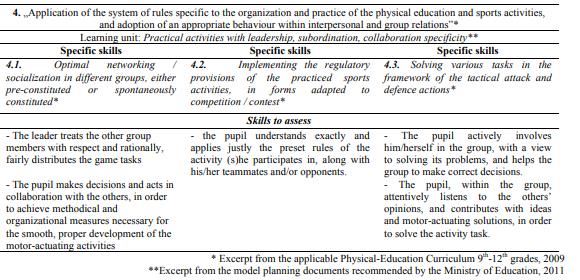
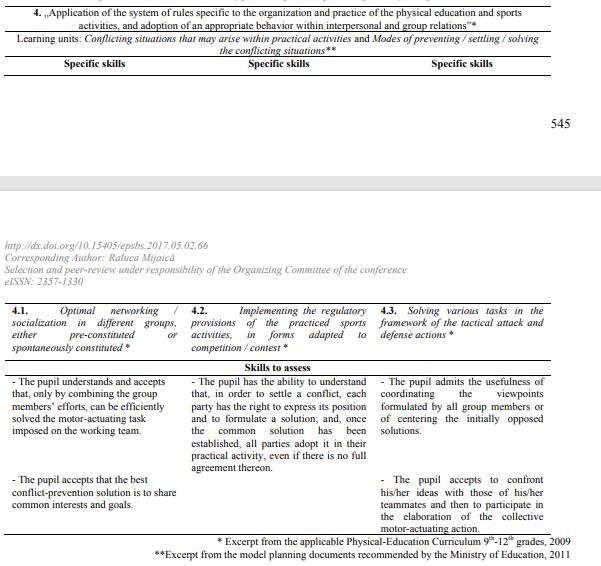
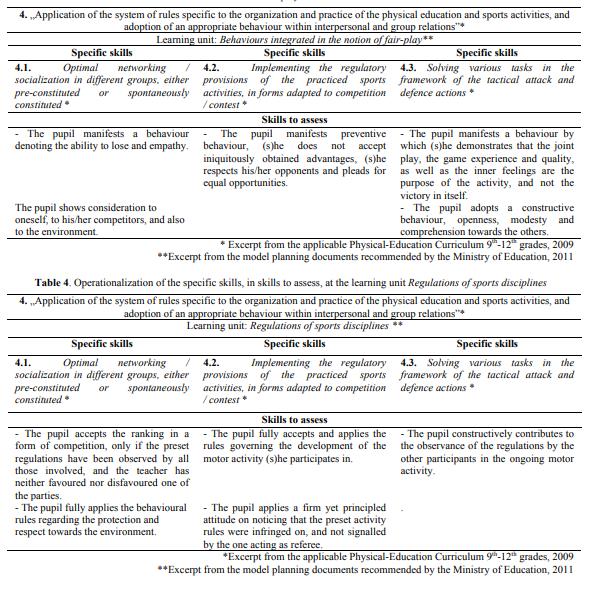
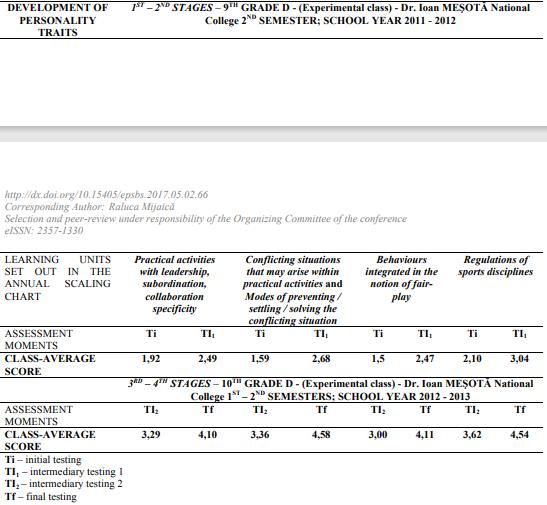
Once the
class (2/week), depending on the attributed/consumed time and on the targeted point of the lesson, we applied actuators consisting of non-formal motor-actuating games, oriented in the direction of forming the specific skills, falling under the category “Development of the Personality Traits”; 6 categories of games were applied (group-member knowledge games, physical-contact games, confidence games, teambuilding games, communication and cooperation games and environmental-protection games), totalling 112 games, with one or more implementation variants, which were distributed in experiential learning structures/ systems, scaled as experiential units, at the level of the 9th experimental grade (2nd semester, 2011/2012) and for the same class, yet 10th grade (fully, throughout the school year 2012/2013). In the same period, at the control-class level (9th-10th grades), the teaching-learning-assessment activities were made in the same college, by the same tenured teacher, but the learning and assessments contents were, on a permanent basis, only those traditionally used in the physical-education classes, in Romania.
The evaluation of the skills specific to the development of the personality traits, both in the experimental and in the control classes, was carried out as moments: initial (Ti, 1st semester, 2011), intermediary 1 (TI1, late 2nd semester – 9th grade, 2012), intermediary 2 (TI2, late 1st semester – 10th grade, 2013) and final (Tf, 2nd semester, 10th grade, 2013). The procedures and the collected data through systematic observation method (Epuran, 2005) at the criterion assessments (initial, intermediary 1-2, final), were made per/for every pupil, by means of individual assessment sheets, which refer to the subjects’ traits – behavioural tendencies, through the skills to assess that we conceived. For each skill, we took over from the investigation method, the procedure of assessment based on the scale of „type Lickert”, with five value ranges, respectively: 1. The trait appears to a very small extent; 2. The trait is present to a small extent; 3. The trait exists to a certain extent; 4. The trait is present to a large extent; 5. The trait appears to a very large extent.
On the same pattern of sheets, we centralized the data averages/classes/targeted learning unit/skill to assess. Processing of these data was performed by statistical and mathematical method, respectively Student test, one which emphasizes the significance of differences between averages, correlated samples. I mention that, throughout the experiment, during the learning, the pupils in the experimental class were subjected – except the independent variable (motor-actuating games) – only to constant teaching factors, exercised by the categories of traditional motor activities (sports activities), currently conducted in physical-education classes, so as to make sure, as far as possible, that there are no other influences exercised on the dependent variable (the pupils’ modified behaviour), than through the independent variable, which was pre-impact established.
6. Findings
The average scores obtained for each skill to assess, in all evaluation stages within the 4 learning units dedicated the development of personality, are shown in a centralized form, in table 5, for the experimental class, respectively table 6, for the control class, as well as in a graphical form, in figures
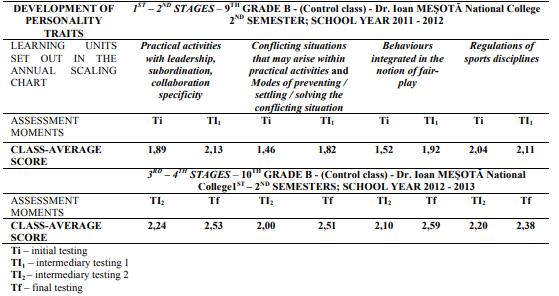
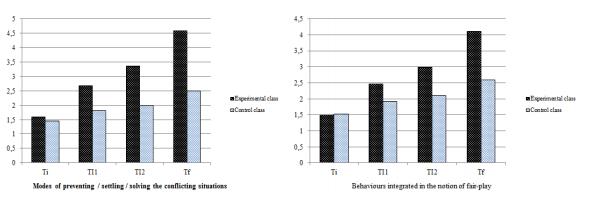

Taking – at the experimental class – the initial and final average scores, for all skills assessed
within the 4 personality-development units - UDP (table 7), we have applied the significance test t
(Student),of the difference between averages, for the correlated samplings (Opariuc–Dan, 2011) and we
have established the materiality threshold of the differences between these averages.

For f = n-1 = 4 – 1 = 3 freedom degrees and a probability of 0,99 (threshold of 0,01), there
corresponds a t = 5,841 (Table of Fischer – Novac, 1995); hence the difference between the value of the
calculated t (7,5368) and the tabular one, is significant. This shows that, with a probability of 99%, the
independent variable has determined the development of the personality traits.
Also for the control class 9th grade B – 10th grade B we have applied the statistical-mathematical
method for establishing the difference between averages (correlated samplings); the average scores
obtained for each skill to assess, within the 4 personality-development units, being shown in table 8.

We have calculated t, by applying the calculation formula (Opariuc–Dan, 2011) and, according to the
table of Fischer (Novac, 1995), for f = n-1 = 4 – 1 = 3 freedom degrees and a probability of 0,99
(threshold of 0,01), there corresponds a t = 5,841; hence the difference between the two values, calculated
t (2,21) and tabular t, is insignificant.
As one can see from comparing the categories of obtained data, the experimental class had, from the
standpoint of the skill acquisition in terms of personality-trait development, a significantly higher
evolution to the control class; a fact due – with a probability of 99% - to the experimentally induced
independent variable (applied didactic methodology).
7.Discussions
In the current context, physical education can no longer be identified only as a predominantly
practical activity, constrained in rigid patterns, which answer neither the options formulated by
practitioners, nor the contemporary requirements imposed by the field of motor-actuating education. The
evolution of formal motor activities must correlate with the existence of natural and social factors,
exercising varied influences on the human body, which has to be regarded as a complex bio-psychical-
social system. This type of approach requires designing an appropriate instructional demarche, focused on
the individual and his/her needs of full, integral development. In this methodological manner, school
physical education can manifest itself as a coherent system with distinct identity, which acts on
personality-development, improving human being, in the sense of empowering him/her to fully express
both the physical and the spiritual sphere, in a balanced and harmonious relation with the natural and
social environment.
The climate generated by the development of the games we applied, was intended to be one of
social experimentation, in which the relations, both with oneself, and the interpersonal ones, of an
unusual intensity, might be explored under controllable conditions. They have given us the possibility of
manifesting different social behaviours, of experiencing roles; opportunities to capture the impact they
have on each other.
In order to reassure the specialists who are still militating in a one-dimensional direction, of the
acquisitions related to the sports motor skills, in the physical-education class, as well as of obtaining
sports performance, at this level of instruction, we have realized for the classes involved in the study, the
differences of teaching time resulted after having implemented our experimental methodology. Thus, of
all physical-education classes, during three semesters (100%), for the experimental class, a duration,
expressed as percentage value, of 23,85%, was consumed, with the new learning contents we proposed
(see the categories of motor-actuating games), others than those set out in the curriculum. Yet, this did not
significantly affect the general averages in physical education of the pupils in the experimental classes,
they being very close to those of the pupils in the control classes, who covered, within the time allotted to
the physical-education lessons, only traditional learning contents.
8.Conclusions
Unlike the current school physical education in Romania, obviously based on coordinates - mostly
- practical and methodological, which promote, across the entire field of manifestation (between the
stages pre-impact – post-impact), the sides regarding the sports-tinting of the educational activities, by the
current research, we have tried to bring to the fore the potential of other motor-expression means, taken
from non-formal education, which exercise a holistic influence upon the individual. Unlike
competitive/sports games, which are well-known and widespread in the Romanian education system, and
whose main aim is the manifestation of the specific motor behaviour (as highly performing as possible),
the games proposed in our methodological approach aim at raising the individual-participation level, at
forming the collective problem-solving capacity, at increasing the players’ self-confidence, the psychical
and somatic-functional tonicity, the physical and mental condition, as well as the solidarity and civic
responsibility.
The methodology we have experimentally implemented, is built on the following benchmarks:
focusing the learning on each participant, the teacher’s role being to share his/her experiences with the
pupils; the essential teaching strategy must be the maintenance of the educational values (respect towards
the others; tolerance, collaboration, protection of the participants’ safety; permanent readiness to lead and
to create positive learning moments etc.).
As regards the games we selected and adapted, both to the subjects and to the current teaching
situation, we have only considered them as tools that the teacher uses, and, implicitly, presents. Although,
in terms of status, (s)he remains an official in formal education, (s)he is withal a reference point – most of
the time – a coordinator – but, sometimes, a player – she may be an animator, trainer or counsellor.
Usually, his/her role does not change along the successive events throughout his/her activity; in the
beginning (s)he leads, later on (s)he leaves much more space and initiative to the pupils and thereby only
supports and encourages the group members, and finally controls and guides the revision moment. At the
end of an activity, the teacher must not necessarily have all the answers to the problems occurred during
the exercise, but – rather – (s)he must identify the answers by exploration, together with his/her pupils.
Although, in terms of lesson duration, there was extracted, for the implementation of the new
contents, over 20% of the total time allotted to the physical-education discipline, considered as being
necessary for covering the learning contents set out in the curriculum, in the case of our research, there
were not signalled, for the students in the two classes (both the experimental and the control ones), more
significant progress or regress aspects, as regards the components of the general and specific motor
capacity, assessed at a national level, which might have been attributable to the experimental factor.
References
- Derlogea, Ş. (2006). Team-building – 50 de jocuri şi rolul lor în consolidarea echipei, Editura Amaltea,
- Bucureşti.
- Epuran, M., (2005). Metodologia cercetării activităţilor corporale, Editura FEST, Bucureşti, 207-225. Korka. M., (2000). Reforma învăţământului de la opţiuni strategice la acţiune, Editura Punct, Bucureşti, 35.
- Neuman, J., (2004). Education and learning through outdoor activities, Published by Duha, Czech Republik Novac, A., (1995). Statistică socială aplicată, Editura Hyperion XXI, Bucureşti. 138 Opariuc-Dan, C., (2011). Statistică aplicată în ştiinţele socio-umane, Analiza asocierilor şi a diferenţelor statistice. Editura Asociaţiei de Ştiinţe Cognitive din România, Constanţa, 216-220 Redmond, K., Foran, A., & Dwyer, S., (2010). Quality Lesson Plans foR Outdoor Education, Human Kinetics, Champaign, IL.
- Roşu, D., (2008). Tehnici de animare – team building montan, Editura Universitaria, Craiova.
Copyright information

This work is licensed under a Creative Commons Attribution-NonCommercial-NoDerivatives 4.0 International License.
About this article
Publication Date
25 May 2017
Article Doi
eBook ISBN
978-1-80296-022-8
Publisher
Future Academy
Volume
23
Print ISBN (optional)
-
Edition Number
1st Edition
Pages
1-2032
Subjects
Educational strategies, educational policy, organization of education, management of education, teacher, teacher training
Cite this article as:
Mijaică, R. (2017). Development And Evaluation Of The Pupils’ Personality Traits, In The Physical-Education Lesson. In E. Soare, & C. Langa (Eds.), Education Facing Contemporary World Issues, vol 23. European Proceedings of Social and Behavioural Sciences (pp. 542-551). Future Academy. https://doi.org/10.15405/epsbs.2017.05.02.66

